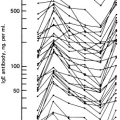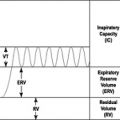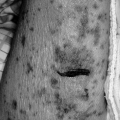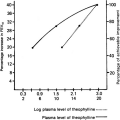The Infant and Toddler with Asthma
Mary Beth Hogan
Nevin W. Wilson
Recurrent wheezing is a common problem among infants, toddlers, and young children. The 2007 National Heart, Lung, and Blood Institute (NHLBI) Guidelines for the treatment of asthma attempt to address the significant problems of asthma in the very young. Despite recent scientific advances, the pathogenesis of recurrent wheezing, its relationship to the development of asthma, and ultimately its treatment options continue to be poorly defined. The purpose of this chapter is to review the factors important in the development of asthma in infants and very young children. The current difficulties of evaluation and management of wheezing in very young children also are discussed. In this chapter, infantile asthma refers to asthma in children less than 3 years of age with four or more episodes of wheezing. These episodes improve with bronchodilators or anti-inflammatory medications and may or may not be associated with viral infections. In many of these young asthmatics, environmental allergy is already playing an underappreciated role.
Epidemiology
The prevalence rate for asthma in infants and young children is increasing, particularly in westernized countries (1). An increase in atopy may be a contributing factor (2). Hospital admission rates are climbing for infants with asthma (3). Asthmatic children under 24 months of age are four times more likely to be admitted to the hospital than teenagers with asthma (4). In Norway, 75% of all children hospitalized for asthma are under 4 years of age (5). Although the number of days in the hospital is declining in older children, hospital length of stay for asthmatic infants is not changing (6). In addition, infants are more likely to require emergency department assistance for asthma exacerbations (7). Ten percent of all childhood mortality from asthma occurs in children under 4 years of age (8). Overall, it appears that hospitalization rates may be improving for older children, but no substantial progress has been made in improving the quality of life of asthmatic infants.
Natural History
Wheezing in infants and young children can be divided into three specific phenotypes: early transient wheezers; late-onset nonatopic wheezers; persistent atopic wheeze/asthma (9). The early transient wheezers have symptoms primarily with viral infections, do not wheeze in between infectious episodes, and are no longer wheezing by the time they are 6 years of age. They often respond poorly to bronchodilators and asthma-controller medications. The late-onset, nonatopic wheezers will wheeze with viral infections and also under other conditions such as exercise. Their prevalence peaks between 3 and 6 years of age and then gradually declines and frequently becomes asymptomatic early in the second decade of life. The third phenotype combines wheezing with evidence of IgE-mediated disease. This atopic phenotype is the group most likely to have persistent wheezing. This phenotype gradually increases until it becomes the most common cause of wheezing by 6 years of age.
Based on these observations, an Asthma Predictive Index (API) (10) was developed to predict which infants were more likely to go on to develop asthma when they were older. It was subsequently modified to include allergic sensitization to at least one aeroallergen as a major criteria and allergic sensitization to milk, egg, or peanut as minor criteria (11) (Table 20.1). In the API, recurrent wheezing episodes in the first 3 years of life was combined with at least one major risk factor consisting of a parental history of asthma or child atopic dermatitis. Two of three minor criteria are required; they include wheezing unrelated to colds, blood eosinophil counts of ≥4%, and physician diagnosed allergic rhinitis. The API was modified and used as the mAPI in the Prevention of Early Asthma in Kids (PEAK) study (12) to characterize the atopic profile of toddler-aged children with recurrent wheezing at high risk of developing persistent asthma.
They found that more than 60% of young children were already sensitized to either food or aeroallergens. Male toddlers were significantly more likely to be sensitized to aeroallergens, to have a blood eosinophil level of more than 4% and elevated serum IgE levels. Eosinophilia and total serum IgE concentration were strongly correlated with aeroallergen sensitization. The presence of allergen sensitization is considered significant criteria for the diagnosis of allergic rhinitis and indicative of increased risk of developing asthma. On the other hand a negative mAPI in the first 3 years of life has been shown to accurately predict 95% of those without persistent asthma between the ages of 6 and 13 years.
They found that more than 60% of young children were already sensitized to either food or aeroallergens. Male toddlers were significantly more likely to be sensitized to aeroallergens, to have a blood eosinophil level of more than 4% and elevated serum IgE levels. Eosinophilia and total serum IgE concentration were strongly correlated with aeroallergen sensitization. The presence of allergen sensitization is considered significant criteria for the diagnosis of allergic rhinitis and indicative of increased risk of developing asthma. On the other hand a negative mAPI in the first 3 years of life has been shown to accurately predict 95% of those without persistent asthma between the ages of 6 and 13 years.
Table 20.1 Modified Asthma Predictive Index | ||
|---|---|---|
|
The PEAK trial was initiated to determine if young children at high risk of developing asthma could be treated with inhaled corticosteroids to modify the natural history of the disease. Guilbert et al. (12) randomly assigned 2-year-old to 3-year-old children with a positive mAPI to treatment with fluticasone propionate (88 μg twice daily) or placebo for 2 years. Patients then were followed for a subsequent 1-year period without study medication. During the treatment period, fluticasone use was associated with more episode-free days, less asthma exacerbations, and decreased supplementary use of rescue medication. However, after the treatment period ended, there was no difference between the treatment group and placebo for episode-free days, the number of exacerbations, or pulmonary function (12). Guilbert et al. concluded that in preschool children at high risk for asthma, 2 years of inhaled-corticosteroid therapy did not provide a subsequent long-term disease-modifying effect after treatment discontinuation.
Care for the asthmatic infant is predicated on the correct identification of asthma versus other conditions that cause wheezing. It is critical to identify triggers such as allergies or gastroesophageal reflux that cause asthma exacerbations. Once any triggers are identified, correct therapy, and ultimately long-term disease-modifying treatments can be delivered.
Triggers of Asthma in Infants
Gastroesophageal Reflux
Gastroesophageal reflux (GER) is a common cause of wheezing in infants under 1 year of age. The clinical difficulty of GER in small children is that it is a trigger for both wheezing and asthma (13). In nonatopic infants with wheezing but without asthma, BAL samples were noted to contain increased neutrophils, lipid laden macrophages, IL-8, and myeloperoxidase. These findings suggest that aspiration associated with GER is characterized by a neutrophilic inflammatory response (13). Sheikh et al. noted that, in a population of infants, silent GER was related to wheezing and that treatment with acid suppression and prokinetics decreased the need for daily asthma medications (14). In fact, 64% of infants with silent GER were able to discontinue all daily asthma medications. However, 73% of infants without GER were unable to discontinue inhaled steroids. In a study of adequately treated, nonatopic wheezing in 1- to 16-year-olds, clinical improvement occurred with acid suppression therapy as compared to a control group (15). These studies illustrate the difficulty in ascertaining which infants and young children have asthma versus which have GER-induced wheezing.
Few studies describe the effect of GER on asthma symptoms or exacerbations in infants. In a population of 5-month-old to 6-year-old asthmatics, Condino et al. noted that equal numbers of acid and nonacid reflux events occurred after a meal. There did not appear to be a direct link of reflux events to symptoms (16). In a controlled study of older asthmatic children, anti-GER therapy did result in a significant reduction in asthma medication (17). A Cochrane analysis has been performed inclusive of adults and children to determine whether GER treatment affects asthma. Broadly, no treatment effect was noted while subgroups did respond to treatment, it was not possible to predict which patients were in the responding subgroup (18).
Passive Smoke Inhalation
Parental smoking is a profound trigger for infantile asthma. Passive smoking increases airway responsiveness in normal 4 1/2-week-old infants (19). Overall, as much as 13% of asthma in children under 4 years of age is estimated to be secondary to maternal smoking (20). In lower socioeconomic households, children of mothers who smoke 10 cigarettes or more per day are at increased risk of asthma (21). Lower socioeconomic children of smoking parents have more emergency department visits
for asthma than nonsmoking parents (22). The likelihood of infantile asthma increases with increasing exposure to smoke by-products (23). Parents of asthmatics often underestimate how much smoke their children are actually exposed to when urinary nicotine metabolites are compared with parental history (24). It is believed that children with glutathione-S-transferase deficiency may be at increased risk for asthma symptoms (25).
for asthma than nonsmoking parents (22). The likelihood of infantile asthma increases with increasing exposure to smoke by-products (23). Parents of asthmatics often underestimate how much smoke their children are actually exposed to when urinary nicotine metabolites are compared with parental history (24). It is believed that children with glutathione-S-transferase deficiency may be at increased risk for asthma symptoms (25).
Fetal smoke exposure during pregnancy is linked to childhood asthma (26) and may play a larger role in the development of childhood asthma than postnatal exposure (26,27). Prenatal exposure to smoke is associated with decreased peak expiratory flow, mid-expiratory flow, and forced expiratory flow rates by the time children become school-aged (28). In fact, this decrease in pulmonary function is noted shortly after birth in apparently normal infants. This increase in risk of asthma due to pre-natal and post-natal asthma is linked to increased risk of adult asthma (29). The most discouraging aspect to this public health problem is that maternal smoking during pregnancy is an entirely preventable cause of asthma.
Outdoor and Indoor Air Pollution
Outdoor air pollution exacerbates asthma. Increased emergency department visits, hospitalizations, and asthma severity among children with asthma are associated with elevated pollution levels (30,31). Increases in hospitalization risk for young children in Hong Kong are reported for every 10 μg/m3 increase in NO2 (32). Infants with asthma also are affected by outdoor air pollution; in fact, the number of emergency department related visits was the highest in this age group (33).
Indoor air pollution is an additional important trigger for asthma in this age group. Prevalance of asthma symptoms is highest in children whose households have open wood burning stoves (34). Wood burning stoves are linked to increased respiratory symptoms in infants due to increased airborne particulate matter (35).
Allergy
Until recently, allergy was not considered a risk factor for the development of wheezing in infants and very young children. Bernton and Brown (36) skin-tested allergic children in 1970 to cockroach allergen and found no child under 4 years of age with a positive skin test. Other early studies also suggested that immunoglobulin E (IgE)-mediated allergy did not act as a trigger for infantile asthma (37). These studies have formed the groundwork for the case that allergy is unimportant to infantile asthma.
The Case for Indoor Atopic Sensitization Affecting Asthma in Infants and Toddlers
In more recent studies, allergy has been commonly found in infants. Delacourt et al. (38) reported that 25% of infants with recurrent wheezing had positive skin test results to either dust mites or cat allergen. The prevalence rate for reactivity to one inhalant in a general population of 1-year-olds and 6-year-olds was 11%, and 30% respectively (39). Wilson et al. evaluated 196 rural children less than 3 years of age with infantile asthma for allergy (40). Forty-five percent of the infants who were tested to indoor inhalant allergens had at least one positive skin test result. For the 49 children who were under 1 year of age, 28.5% had a positive skin test to cockroach and 10.2% to dust mite. Welch et al. subsequently demonstrated that mouse allergy is present in 12% of asthmatic children (41). Cockroach sensitization is linked to previous episodes of wheezing in young children (42). Increased cockroach allergen in family rooms is associated with wheezing in the first year of life (43). In addition, 30% of asthmatic children may have sensitization to flying insects such as mayfly, housefly, caddis fly, moth, and ant (44).
These sensitizations have significant clinical implications. Frequent use of humidifiers is associated with increased wheezing. Damp housing increases the likelihood of a diagnosis of asthma in infants and increases the hospitalization rate (45). Visible moisture damage, particularly in the bedroom or main living quarters, was linked to new asthma cases in infants and young children (46). Sensitization to mouse, presumably from indoor exposure has been linked to increased asthma symptoms and hospitalization in very young asthmatic children (47).
The Case for Aeroallergen Sensitization Affecting Asthma in Infants and Toddlers
Many allergists have been reluctant to test very young children and infants to aeroallergens. However, recent studies suggest that aeroallergen sensitization in very young children may in fact occur despite “common wisdom.” In a birth cohort study, aeroallergen sensitized 4-year-old children had significant allergic diseases such as asthma (48). Forty-two percent of children sensitized to grass had asthma. In addition, a majority of children were already sensitized to more than one allergen and this increased sensitization was associated with an increased risk of asthma (48). Ogershok et al. found that while no children under 12 months of age had aeroallergen sensitization, an astonishing 29% of 12- to 24-month-olds with asthma were pollen sensitized (49). In this study, equal numbers of 3-year-old asthmatic infants and toddlers were sensitized to pollen as to indoor allergens. Overall, 40% of asthmatic children between 12 months to 36 months of age were noted to be pollen sensitized. In another study, up to 52% of children less than 3 years of age with asthma were sensitized to pollen (50). This early sensitization to pollen in wheezing infants predicted subsequent asthma through adolescence (51). As of yet, there have not
been studies of the effect of pollen sensitization on rates of infantile asthmatic symptoms or hospitalization. However, it is well documented in older individuals that aeroallergen sensitization is linked to increased pediatric hospitalizations, and emergency department visits for asthma exacerbations during the concurrent pollen season (52–54).
been studies of the effect of pollen sensitization on rates of infantile asthmatic symptoms or hospitalization. However, it is well documented in older individuals that aeroallergen sensitization is linked to increased pediatric hospitalizations, and emergency department visits for asthma exacerbations during the concurrent pollen season (52–54).









